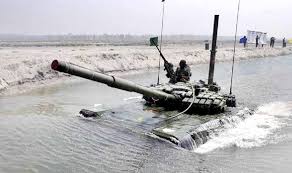NEW DELHI: The five Army men who recently drowned in the Shyok river in eastern Ladakh had battled the gushing waters for almost six hours before being washed away, Army sources said. A Court of Inquiry, which is currently underway, is looking at multiple angles behind the mishap.
The incident took place at 1 am on June 20 when the Army men were crossing the river in a Russian T-72 tank as part of a drill to practice movement in exigency. The exercise was being held at a mountainous terrain at an altitude of more than 13,000 ft. The tank got stuck in the river due to a sudden increase in the water level.
With their tank getting submerged and rescue efforts underway, the five stood on the top of it for almost six hours before the river washed them and the tank away, the Army sources said. The Shyok was flowing at almost 40 km per hour that night. The Army’s attempts to launch rescue missions failed with one rescue team barely surviving a mishap of its own. The Army’s 14 Corps headquartered at Leh, in a statement on X on June 29, said the incident happened while the tank crew was de-inducting from a military training activity. “An army tank got stuck in the Shyok river, near Saser Brangsa, Eastern Ladakh, due to a sudden increase in the water level.”
Rescue teams rushed to the location, but due to heavy water current, the rescue mission couldn’t succeed and the five tank crew members lost their lives, the Army had said.
Giving details of the incident, the sources said the Army had specialised boats on standby, called BAUT (boat assault universal type). One such BAUT was launched to rescue the tank crew, but it capsized in the fast-flowing river and the rescue team barely survived.
Tanks have the ability to float in the water and keep moving forward. A column of tanks was crossing the fast-flowing Shyok river as part of the exercise in the dead of the night. The five were in the last tank in the column. In Eastern Ladakh, the Army has identified spots where tanks can cross the Indus and some its tributaries.
The Shyok that descends from the Eastern flank of the Rimo Kangri glacier is a rapidly flowing tributary of the Indus. There was a sudden increase in its water level due to the melting of snow. The terrain is tree-less and the water after the melting of snow at the mountain peaks rushes straight into the river running through the valley. The river is about 60-70 m wide and swimming in these conditions would have been impossible for the rescue team as also for the five who got washed away, the sources added.


